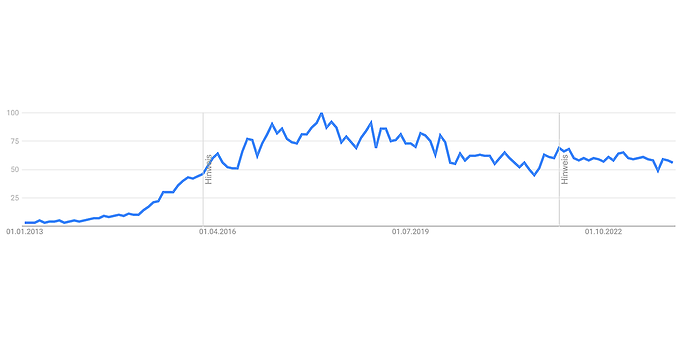8. March 2024 By Dr. Olaf Neugebauer
Is the Internet of Things dead?
In recent years, the Internet of Things (IoT) has been on everyone's lips, promising to revolutionise the way we work and live in all industries. IoT devices, sensors and networks have been hailed as "the next big thing".
But as with any technology trend that is heavily hyped, the question arises: is the Internet of Things dead? Some argue that IoT projects are too expensive, too complex, too insecure and simply not profitable. Others, however, are convinced that the future is unimaginable without IoT.
The IoT journey
Before we turn to the current state of IoT and smart, connected products, let's take a brief look back. The IoT emerged as a concept in the early 2000s. According to Google Trends, demand for IoT began to rise sharply in 2014. The technology became more mature and received more attention. Companies began to invest heavily in the Internet of Things, envisioning a world where everything from individual devices to complex industrial machinery is connected and provides valuable data for better decision-making. Some key data:
- 2016 – Start Azure IoT Hub
- 2017 – Start AWS Greengrass
- 2018 – Start Google Cloud IoT Core
The peak of the hype
The Internet of Things reached its peak in 2018-2019: analysts predicted billions of connected devices and an economic impact in the trillions. Every industry seemed to want to use the IoT - there was talk of smart cities, digitalised healthcare and automated and intelligent manufacturing. Start-ups and established companies alike were trying to capitalise on this emerging market.
The buzzword "intelligent, networked products" came up time and again. These are physical products that are equipped with sensors, software and connectivity to offer new functions, improve performance and collect data for analysis.

Search queries on the topic of IoT from Germany in the years 2013-2023, source: https://trends.google.com/trends/explore?date=2013-01-01%202023-12-31&q=IoT&hl=de
Current status of IoT and smart, connected products
In recent years, however, the Internet of Things has also brought with it a number of challenges. These include high implementation costs, the complexity of data analysis and security risks. These challenges have led some companies to postpone or abandon their IoT projects altogether. Of particular note is the cancellation of dedicated IoT services from Google (IoT Core EOL 08/2023) and IBM (Watson IoT Platform - EOL 12/2023).
Is the Internet of Things dead? By no means! The hype may have died down, but the IoT is far from dead. It has evolved and matured into a ubiquitous technology. Smart, connected products have become mainstream, providing a better experience for consumers and valuable data for manufacturers. In my opinion, we have passed through the "valley of disappointment" after the hype cycle and are approaching the "plateau of productivity". The IoT is a constantly evolving technology that has become an integral part of many industries. However, the diversity also shows that a generalist "out-of-the-box" or "we-network-everything" approach does not work. This is why we are seeing more and more domain-specific IoT platforms and applications. In general, however, I would like to emphasise two relevant developments.
The power of connection - data platforms - smart product platform
The real added value is created when the collected data is utilised profitably. This is where data platforms, sometimes also called smart product platforms, come into play. These platforms not only collect IoT data, but also enable the simple linking of different data sources and the derivation of new data-driven applications. For example, IoT machine data can be linked with the service history from SAP and provide information on upcoming maintenance (predictive maintenance), thereby reducing the burden on service. Data platforms form the backbone of a modern IT landscape, enabling data-driven decisions or the development of new data-driven services/products. It is therefore recommended that companies define a data strategy and address the topic of data platforms.
IoT as a data generator in combination with AI and GenAI
The combination of Generative Artificial Intelligence (GenAI) and IoT opens up new opportunities for automation, intelligent data analysis and value creation. GenAI, which is considered the Swiss army knife of text and language processing, can be used to gain valuable insights from the data collected by IoT devices. In addition to IoT data, such a system also accesses other data such as manuals or maintenance reports.
For example, natural language questions such as "Why is my machine not running?" or "How can I optimise the use of my machine?" can be asked of a GenAI system. GenAI systems can also be used in training and thus relieve the burden on existing personnel.
Conclusion
The initial hype surrounding the Internet of Things has died down, but the technology itself is alive and well and continues to develop. IoT and intelligent, networked products bring their own challenges and opportunities. As key data providers, IoT systems are essential building blocks of a modern data strategy and data platform. These form the basis for data-based decisions. In the future, we will see more and more AI systems that run on IoT devices or rely heavily on their data. Even if the term IoT is no longer so present, the devices are omnipresent.
Would you like to find out more about exciting topics from the adesso world? Then take a look at our previous blog posts.
Also interesting:

